14 exceptional new restaurants for a better 2021
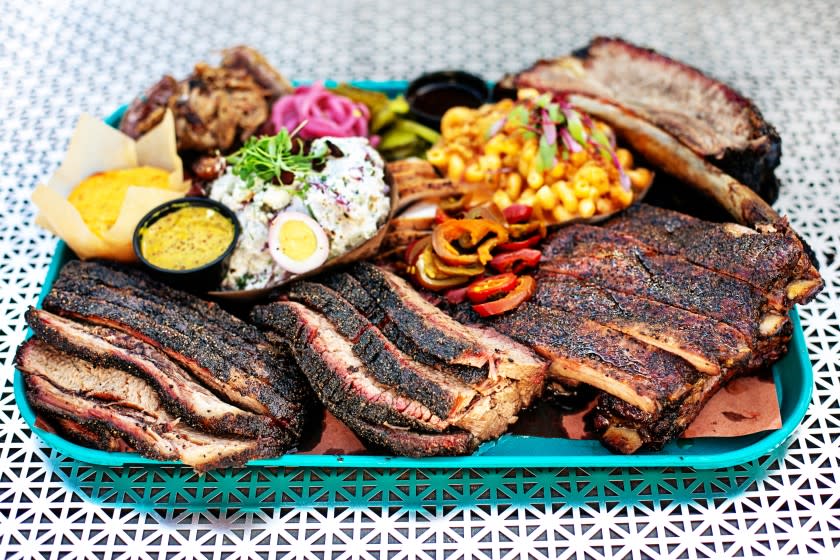
A takeout window seems an apt location to begin thinking through some of the Los Angeles restaurants that managed not only to open in 2020, but also to enrich the city’s culture with creative achievement and personal narrative. This carryout setup operates from the quiet interior courtyard of Chinatown’s Mandarin Plaza, its mustard-colored façade embellished with a lone ribbon of red neon. Out of its sliding-glass panes appear outlandish sandwiches devised by one of the city’s defining chefs.
Wes Avila, the creator of Guerrilla Tacos, opened Angry Egret Dinette in late October. One of his early imaginings was the Mookie Melt, a bucking bull on a bolillo roll that charged wildly and deliciously in all directions.
Black Forest ham and Gruyère fell in kerchiefed waves over a fried chicken thigh; tomato salsa pooled in the crunchy nooks of its encasing batter. Whole confited mushrooms, the size of strawberries, propped up the chicken from underneath, but they also threatened to roll off the bundle I needed both hands to wrangle. It was an unwieldy meal for an unmanageable moment in history, and eating it felt profoundly reassuring.
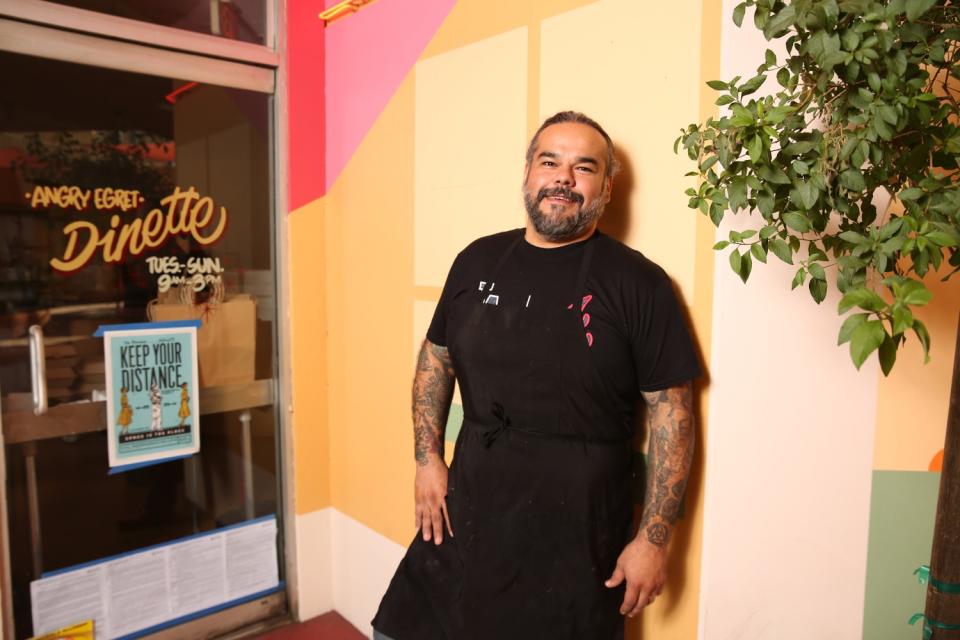
Over the months Avila has reined in the Mookie Melt (nicknamed for the Dodgers’ new star right fielder, Mookie Betts): In its current to-go-only form the beast arrives tightly constrained in foil. The thigh is now grilled, its spices staining everything near it yellow-orange, and crammed among poblano salsa, cheese and slices of candied bacon laid like staggered roofing shingles.
The sandwich is a constant on an otherwise kinetic menu that might include a po’ boy filled with fried shrimp, a crunchy duck breast banh mi and a breakfast burrito heaving with frilly braised pork, scrambled eggs, potatoes, pintos and queso Oaxaca. A recent lamb torta special came with jus from the roasting pan for dipping. I drank it like soup to finish lunch. Speaking of which: Avila mentioned recently on Instagram that his rich, bright sopa de albondigas was the dish that won over his now-wife. It will inspire devotion in most anyone.
His cooking is in the kind of electric zone that reminds me of the first tacos — shrimp scattered with pine nuts and a cranberry bean/fried egg/almond situation — that I ate from the Guerrilla Tacos truck in 2014 outside a Culver City coffee shop. Earlier this year Avila parted ways with the permanentlocation of Guerrilla Tacos opened in the Arts District in 2018; Angry Egret Dinette is an outlet for him to continue exploring the liminal spaces between tradition and innovation. Avila began Guerrilla Tacos from a street cart. He knows how to be nimble. I’ll never adjust to savoring the foods of a chef at the height of his powers from behind the wheel of my parked car. But here we are.

Like all food writers grappling with the decimation of the restaurant industry during a prolonged, mismanaged pandemic, my colleagues and I have hemorrhaged words about the heartbreak of closures; the inequities and issues around race, immigration, gender and labor in restaurant culture laid barer than ever before; and the failure of government to support small businesses and the workers they employ. A big part of me wanted to skip the annual glance back to the year’s finest new restaurant openings. Shouldn’t every independent restaurant that remains in business be considered a success story?
And yet what a tonic, during some of the nation’s grimmest months, to become acquainted with exceptional new restaurants pulling off not only delicious food but the things we need most right now: solace, diversion, community, inspiration.
A few of these meals I experienced in an actual dining setting: There was a stretch in late summer and early fall when COVID-19 cases were dropping locally and I ate outdoors in environments where safety precautions appeared to have been enforced as effectively as possible. Mírame in Beverly Hills, for example, had built a streetside pod similar to every tony restaurant in the surrounding blocks: a fence between the street and sidewalk, dividers between a short row of tables, space heaters and retractable umbrellas and bottles of hand sanitizer on the nearby host stand.
Joshua Gil’s sculpted ceviches and tacos reflected the glamour of the Golden Triangle, though his flavors expressed a soulfulness that transcends surface notions of luxury. His campechana arrived in a clear glass bowl: shrimp, scallops, octopus, cucumber and hunks of avocado steeped in a briny, citrusy marinade, offset and also magnified by an ice patch of granita infused with black lime. Snapper fished from Baja waters was fried until its skin, scored in crosshatches, crackled against the Sonoran wheat tortilla I used to tear off meaty lumps.
Gil trained his global view through a sharply focused Mexican lens: Saffron-pickled fennel brightened sticky lamb barbacoa riblets; shaved black truffles and preserved lemon brought funk and sunshine to a kampachi tostada.
With outdoor dining banned, Gil has temporarily narrowed the menu’s focus to brainy tacos (fried chicken with tomato, Brussels sprout leaves and black lime gastrique), quesadillas, and solaces like seafood pozole verde. His cooking brings to mind the wide-open perspective of the best chefs in Ensenada’s Valle de Guadalupe; I’m trusting Mírame finds the audience it deserves when this crisis abates.
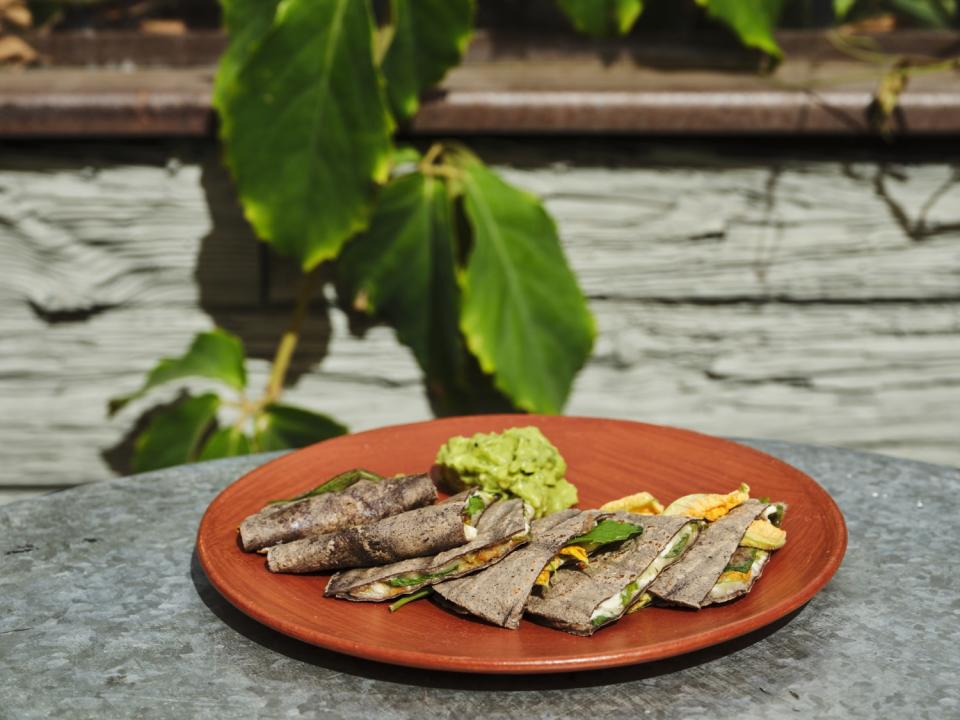
On the subject of pozole: Maria Elena Lorenzo’s version at Tamales Elena y Antojitos in Bell Gardens is stunning. A blanket of garnishes (among them radishes, chopped cabbage, a slip of avocado, a wedge of queso fresco and curls of chicharrones) covers a broth of pork and chicken stock tinted green with a purée of tomatillos and herbs.
The family-run restaurant showcases the Afro-Mexican cooking of Costa Chica, a hilly stretch along the southern coast of the state of Guerrero; Lorenzo’s daughter Judept runs the kitchen. I ate my pozole slowly on the restaurant’s small patio in September, paired with a signature red chile-stained pork tamale wrapped in a banana leaf.
That same week I had dinner in the tiered outdoor space behind Valle, the Gjelina Group restaurant in Venice that replaced the company’s Japan-inspired MTN. Pedro Aquino and Juan Hernandez both cooked there; now they channel their Oaxacan heritage into quesadillas flecked with squash blossoms and tlayudas overlaid with grilled cactus strips and oyster mushrooms or marinated pork collar meat. They also happen to make an excellent, warming seafood pozole.
***
Like the majority of us, I ate most of my restaurant-prepared meals at home (ordered and picked up, as much as I could, directly from the restaurant to minimize the fees they would otherwise owe to delivery services). The compelling interpretations of pozole were part of a clear, unsurprising throughline among the standout dishes served by newcomers this year: comforting foods.
Some necessary conversations are happening in journalism around the meaning and value of comfort foods. Does the genre help keep culinary culture (and, by extension, society) mired in a regressive, myopic stagnation for the sake of nostalgia? Or can these foods connect us to personal histories, ours and others', and bring a few moments of welcome relief when everything in the world feels awful? The lines can cross and blur.
Admittedly, I found contentment the past year in foods that registered critically as first-rate and that also resonated with my individual experience. I’m a native of the South who’s lived all over the region. A spread of smoked meats and sides from pitmaster Daniel Castillo’s Heritage Barbecue in San Juan Capistrano soothed me body and soul. Pulled pork, beef rib with lava-red meat underneath its blackened crust, borracho beans, and mac and cheese shot through with chorizo exalted the merger of Texas-style barbecue and Mexican American flavors that has been building toward a crescendo in border states, including California, for the last decade.
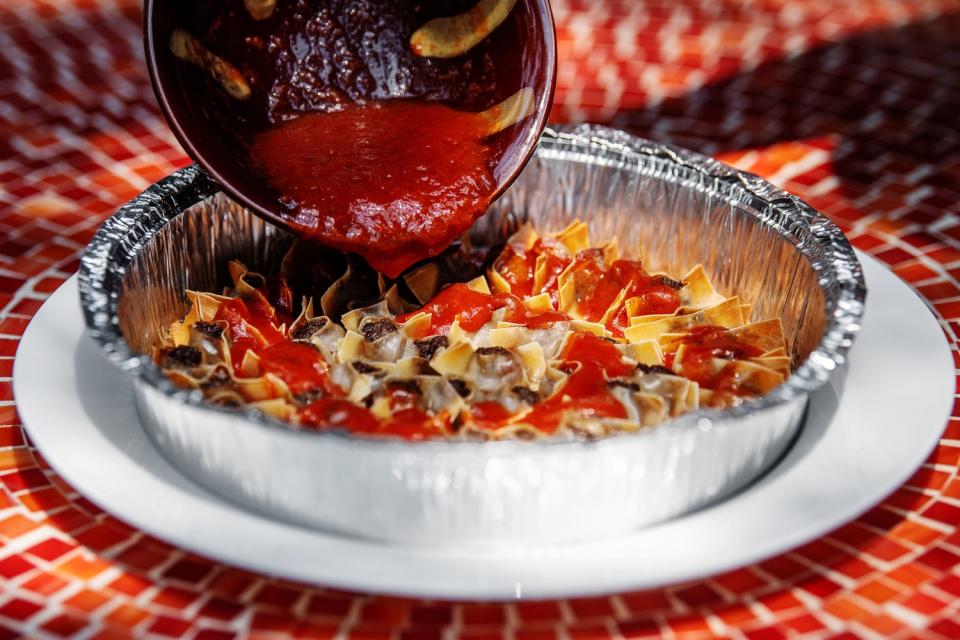
My closest friend and an ever-growing number of my chosen family members come from or live in Lebanon. Chef Silva Bilamjian (who grew up in Lebanon) and her husband, Hovig Bilamjian, took over Zephyr in Pasadena in 2020, revamping the menu with dishes that go beyond the kebab-hummus-shawarma standards. For breakfast I want a manoushe rolled up with cheese and za’atar and Bilamjian’s fatteh, the dish of soft chickpeas, fried shards of pita, tahini and pine nuts. Her richly textured version of kibbeh labanieh (beef and bulgur croquettes submerged in yogurt sauce flecked with mint) is my favorite in Southern California.
More broadly, the finest comfort foods that emerged in 2020 roundly represent Los Angeles: its pluralism, its fluidity, its complexity.
I love that at Pearl River Deli, in Chinatown’s Far East Plaza, Johnny Lee makes public his ambivalence about Hainan chicken and rice, the dish on which he built his reputation at Side Chick in the Westfield Santa Anita mall. He sometimes makes a finite number of orders as a weekend special. (In August he — jokingly? — posted “Hainan chicken club” rules: “Don’t ask about Hainan chicken” was one of them.) Lee wants his customers, deservedly, to equally embrace his silky scrambles with shrimp or char siu, his chow fun and his delicate shrimp fried rice. The restaurant is fundamentally Cantonese but he also occasionally delves into Taiwanese turkey rice or chicken wings marinated in Thai fish sauce and spices. His menu is a living, mercurial document.
It made sense in 2020 for chefs to channel their mastery into sandwiches. Between Angry Egret Diner and Pearl River Deli (which serves an amazing Macao-style pork chop bao) in Chinatown sits Katsu Sando, Daniel Son’s ode to Japanese convenience-store sandwiches he’s evolved through pop-ups at his now-closed West Hollywood restaurant Kura and a stall at Smorgasburg L.A. I fell first for his honey walnut shrimp variant assembled, as are all his sandos, on honey milk bread baked in-house. Lately I’m feeling the menchi katsu sando, an egg-battered, deep-fried burger made from Australian Wagyu — requested, always, with a side of Wagyu curry cheese fries.
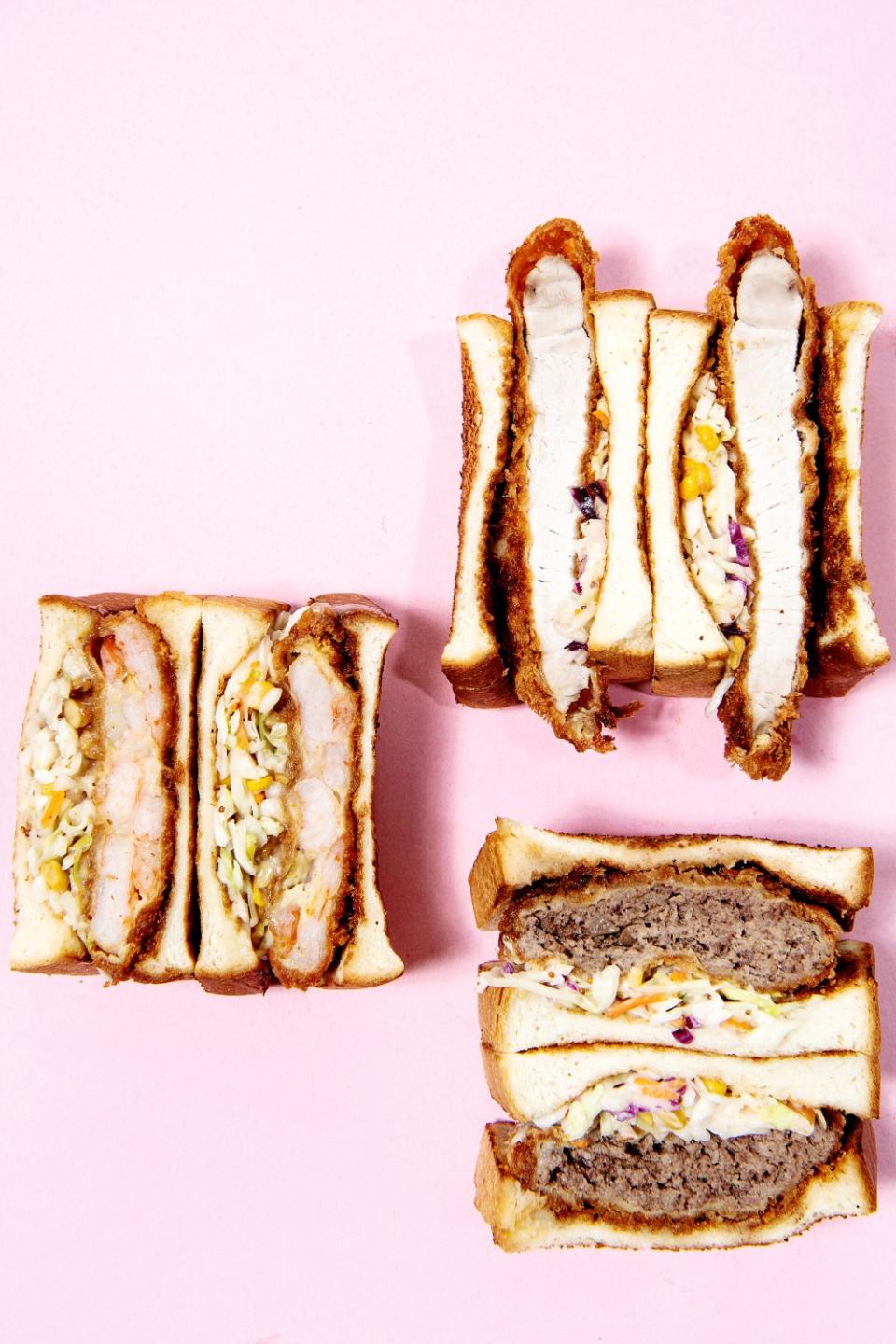
My colleague Jenn Harris has raved about the spicy pork num pang at Hak Lohn’s Cambodian restaurant Gamboge in Lincoln Heights. He piles grilled pork (marinated in galangal and other herbs), papaya slaw, cucumber, pork pâté, chile sauce and seasoned mayo onto a bolillo roll. I’m also a fan; the creamy pulled chicken sando is deeply satisfying as well. Disappear into the chicken porridge available only on Saturdays.
Of course, there has also been the comfort of melted cheese. Pizza is thriving in the pop-up space; Among new bricks-and-mortars, Little Coyote in Long Beach impresses with its thin, puffy-edged pies (and its affordable selection of pizza-friendly natural wines). Jonathan Strader and Jack Leahy don’t overreach with zany toppings. Good ingredients and the bready tang of the dough make a red-sauce pizza with Italian sausage, mushrooms and mozzarella a thing of beauty. I might admire their hefty meatball sub even more.
The crispy provolone from Ospi in Venice, slathered with vodka sauce, is an object of desire I eat with messy obliviousness in the car before driving home to rewarm the rest of the meal: cannelloni baked with lamb neck, pine nuts and tomato sauce; a pizza scattered with toothy sopressata, honey and chiles; and a small but mighty crab cake that even a cantankerous Marylander can appreciate.

Dean Yasharian’s French onion soup is classic: caramelized onions, beef broth, white wine and sourdough, crowned by a magnificent, molten wad of Gruyère. He’s been on a ride this year with the opening of his Pasadena bistro, Perle, which was originally slated to begin service the week of the March shutdown. Currently he’s crafting takeout menus inspired by regions and cities in France, beginning with Paris: Soupe a l’oignon shares the table with black truffle salad, steak tartare, duck confit and optional dishes including sole meunière and a beautiful tarte tatin with cinnamon-labneh cream. General manager and sommelier Roderick Daniel’s French-centric wine list has been gradually expanding over the last few months; ask him for suggestions on Loire Valley whites and Rhone reds.
Grabbing an order from Perle, I peer into its dining room — carved wood ceiling, banquettes, globe light fixtures over the bar — imagining what it will be like to finally have dinner in there. That’s even truer for Chifa, the Chinese-Peruvian restaurant that opened on Thanksgiving weekend. The building’s Space Age green glow, with its tilted, heart-shaped window, pulls you in like a tractor beam. Then you gawk at the dining room: an ’80s fever dream with low, emerald-colored velvet seats, zebra stripes racing over one wall and scallop-edge seashells along the seafoam-speckled tables.
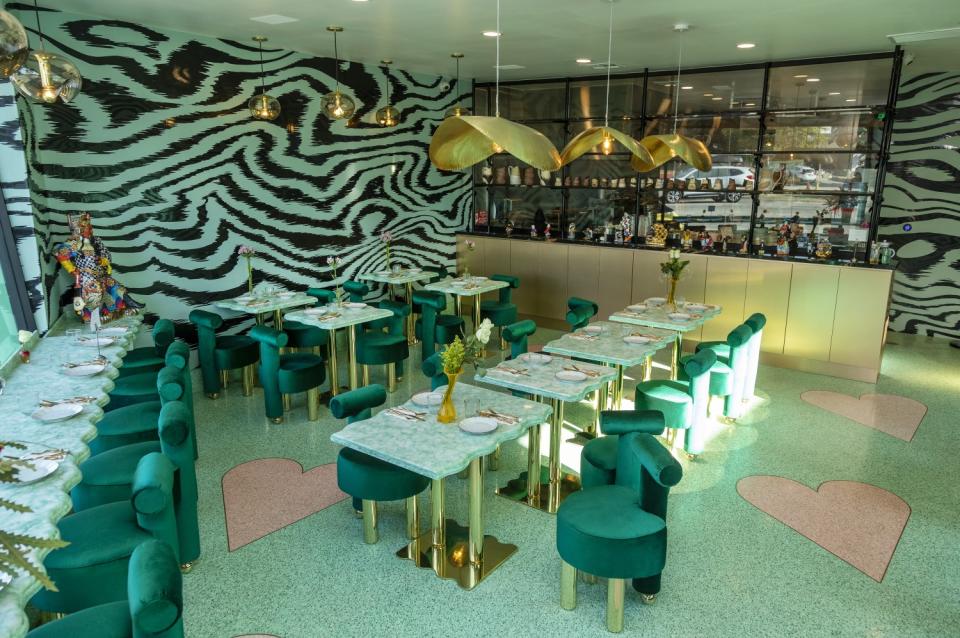
It’s the work of Humberto Leon, who cofounded the fashion brand Opening Ceremony, and his family; the restaurant is in part an homage to the restaurant his mother, Wendy Leon, ran in Lima, Peru, four decades ago. Some Peruvian dishes make evident the long influence of Chinese immigrants on the country’s cuisine; soy sauce is an innate seasoning in lomo saltado. The dishes on Chifa’s menu include wood-grilled chicken with fries and anticucho (beef hearts) but lean more distinctly Chinese: zongzi (steamed sticky rice with meats, vegetables and duck egg yolk bundled in a bamboo leaf), fragrant beef noodle soup and black pepper prawns. It’s painful to wait outside for takeout, staring into the space that, when empty, looks more like the wing of a design museum than a dining room awaiting customers.
Likewise, the 275-square-foot downtown storefront that houses Petite Peso has yet to see its seven counter seats occupied. Chef Ria Dolly Barbosa opened her Filipino restaurant with partners Tiffany Tanaka and Robert Villanueva in April in the downtown space where Charles Olalia had won the city’s heart with his pioneering Ricebar. Barbosa had attuned Petite Peso’s menu to the moment. A sly French dip chicken sandwich with adobo jus for dipping cast a palliative spell; so did rice bowls of kare kare vegetables, coconut-rich adobo and braised pork belly. As 2020 wound down, she ventured into more traditional recipes: a centering stew of boiled beef and vegetables called nilaga, and sinigang, a sour, umami-revved soup hearty with pork belly and shoulder. Are these dishes harbingers of what Barbosa might add to the menu once the pandemic abates?
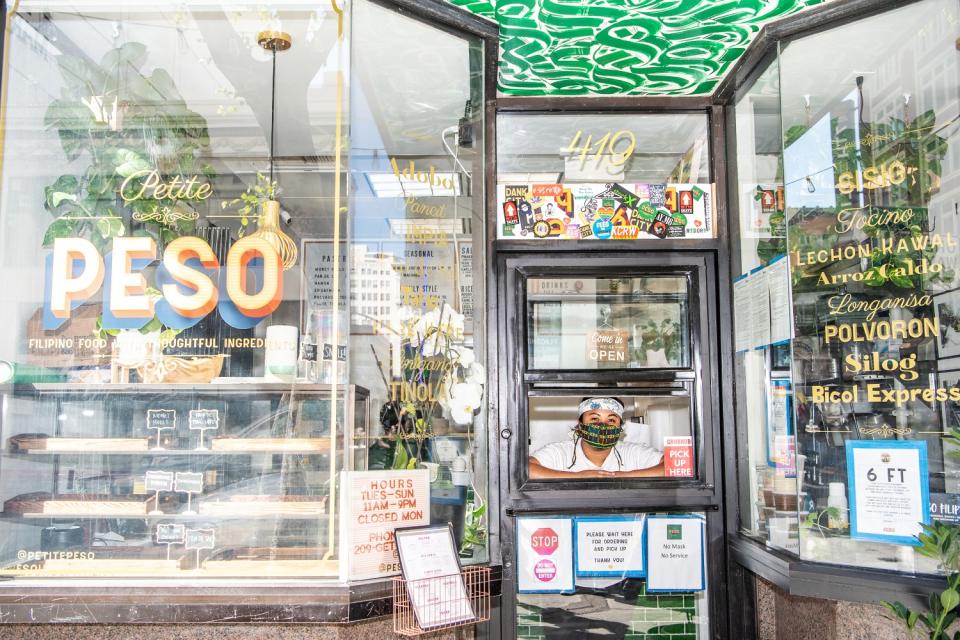
That remains pending. For now the owners have shifted the business model to Peso Goods, selling frozen lumpia, hoodies and adobo French dip kits. The menu has been removed from the website for now. Petite Peso’s homepage feels like a placeholder — a bookmark in a memoir you can’t wait to pick back up and immerse yourself in again soon.
This story originally appeared in Los Angeles Times.

